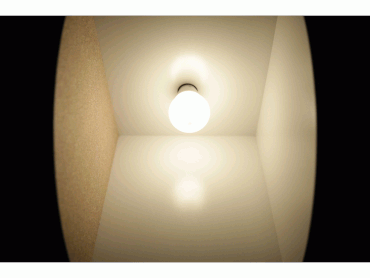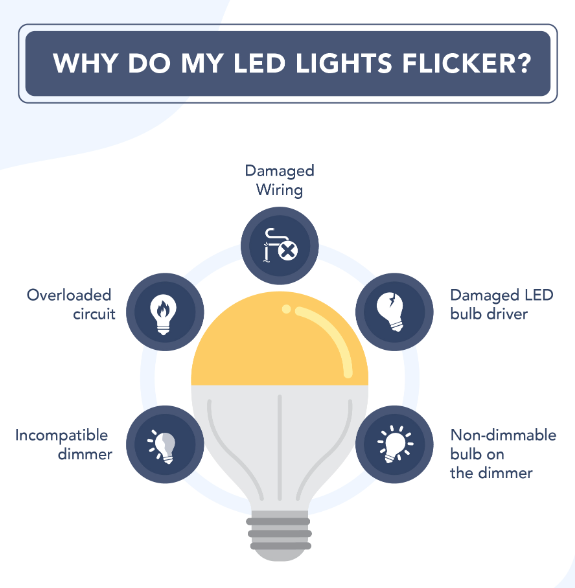If you’ve been puzzled by your LED lights flickering like they’re throwing an impromptu rave, then you’re in the right place. Yes, flickering LEDs are more common than you might think, but there’s no need to worry – they can be fixed with relative ease. So, settle in, grab a cup of tea or coffee, and let’s get to the bottom of this light show.

Before we shine a light on the possible culprits behind this flickering phenomenon, it’s important to get familiar with our main character – the flicker. Now you may ask, what is flickering, exactly? Could it be harmful to your health? Does it affect the lifespan of your LED fixtures? And should you be bracing for a light bulb explosion? These are all great questions, and we’re here to answer them.
What is Flickering?
Flickering is essentially a fluctuation in the stability of the light output from your light source. It manifests as a repetitive variation in brightness, often occurring within seconds. To paint a picture, think of flickering as an irregular heartbeat for your light bulb – an unsteady pulse causing a rapid on-and-off blink. This inconsistent light pattern primarily stems from oscillations in your power supply. It’s as though your bulbs are grooving to a beat that only they can hear!
But why should you care about flickering? That’s an excellent question! Flickering is more than just an annoyance. It indicates that your LED lights are not receiving a stable power supply, leading to inconsistent lighting that could even cause headaches and hamper concentration.

Remember, LEDs are delicate. They demand a precise power supply, and any fluctuation can send them into a frenzy of flickers. But what could cause such disruptions? It could be anything from a power surge, a mismatched dimmer, a loose connection, or even dust particles playing hide-and-seek in your light fixture!
Now that we’ve uncovered what flickering is and why it occurs, we’re ready to delve deeper into this LED saga. Next, we’ll be exploring the various types of flickering, their potential impact on your LED lights, and then turn our magnifying glass onto the primary causes of LED flickering. Lastly, we’ll arm you with the best solutions to put an end to this dance of the flickers. So, shall we proceed?Types of LED Flickering
Did you know that not all flickering is created equal? As we dive deeper into the sea of LED flickering, we stumble upon two intriguing types: Visible Flickering and Invisible Flickering. Let’s get acquainted with these two.
Visible Flickering – It’s all in the name! Visible flickering is the kind of flicker that turns your living room into a disco floor, visible to the naked eye. This phenomenon usually occurs when the frequency drops below 100 Hz. However, for those with a heightened sensitivity to light flickering, frequencies between 3Hz to 70Hz can even trigger short-term epileptic seizures. Frequencies lingering in the 15Hz-20Hz zone are notorious for causing long-term health issues.
Invisible Flickering – Sounds like a mystery, doesn’t it? Well, it’s not far from the truth. Invisible flickering is the flickering that flies under the radar, going unnoticed by the naked eye. But don’t let its subtlety fool you. Even though it doesn’t turn your room into a light show, it can still be the culprit behind nagging health issues like headaches, dizziness, migraines, and nausea.
Is Flickering Bad for LEDs?
Now, let’s tackle a frequently asked question: is flickering detrimental to LEDs? The answer, unfortunately, is yes. If your LED lights are flickering due to something as significant as a power surge or a sudden spike in voltage, it could indeed cause your bulb to burst. Loose wiring, another common culprit behind the flickering phenomenon, could also potentially lead to your bulb going out with a bang. In essence, if your LED flickers due to these reasons, there’s a significant risk of it meeting a rather explosive end.
The Major Causes of Flickering LED Lights
Understanding the root cause of LED flickering is vital to finding a solution. Here are some of the most common causes:
Faulty LED Drivers
A principal character in our LED flickering drama is the LED driver. It’s the unsung hero behind the scenes, regulating the power supplied to your LED lights. If something goes awry with the driver, flickering often takes center stage.
Consider the LED driver as the maestro of the lighting show, orchestrating the flow of current and voltage to your LED circuit. Besides providing power, the driver must keep the power stable, navigating any heat-induced turbulence in the circuit that could disrupt the input power.
In its secondary role, the LED driver works as a transformer, modulating high voltage to the LED’s level. This modulation matches the type of power your LED needs, whether constant current or constant voltage.
When an LED driver goes rogue, it leads to a lighting fiasco, your LED starts to flicker, akin to a candle flickering in the wind. Beyond creating a flickering spectacle, a defective driver can damage your bulbs, shorten their lifespan, and in the worst cases, even risk an explosion due to heat accumulation.
So if your LEDs are putting up a flickering performance, the first thing to examine is the LED driver. This unsung hero might be out of sight, but should never be out of mind when troubleshooting flickering LED lights.
Voltage Fluctuations
Voltage fluctuations are notorious culprits behind LED flickering. Think of them as uninvited guests, disrupting the consistent and smooth flow of power that your LEDs love.
This instability in the power supply can occur when you turn on a heavy-duty electronic appliance within the same electrical system. Like a wave crashing on a serene beach, this sudden power surge can send your LEDs into a flickering frenzy.
What’s intriguing about this type of flickering is its transient nature. It tends to last only a few seconds, appearing intermittently and usually settles down as the voltage finds its balance. So, if your lights are throwing flickering parties at different times of the day, voltage fluctuations could be the party planners.
This begs the question – what causes these voltage fluctuations?
- The Sudden Rush: Inrush Current from Heavy Appliances – These are your washing machines, air conditioners, and other power-hungry appliances that require an initial surge of current when they start up. This sudden power demand can cause a temporary dip in voltage, translating into flickering LED lights.
- The surge in Wattage – A sudden spike in power can happen due to a multitude of events, like a power surge from the grid, lightning strikes, or when a large appliance switches off. This abrupt increase in power can destabilize voltage, causing your LED lights to flicker.
- Overloaded Circuits – When too many devices vie for power from the same circuit, it can become overloaded. This results in voltage drops, and you guessed it, flickering LED lights.
- Fluctuations in the Power Grid – Issues at the power station, damage to transmission lines, or high demand during peak times can cause unstable power supply from the grid, leading to voltage fluctuations in your home.
- Poor Electrical Wiring – Voltage can also fluctuate due to old, damaged, or low-quality wiring. Issues like bad connections or insulation, wire corrosion, or wiring that is undersized for the current demand can all contribute to this problem.
- The Ripple Effect – Some regions manage peak-time demand with a technique called ripple control, which involves reducing the power supply to certain areas. This reduction can lead to less power coming into your home than usual, causing your LEDs to flicker, especially if other appliances are drawing significant power.
Using Incompatible Dimmer Switches with LED Lights
Using incompatible dimmer switches with LED lights can cause flickering. Dimmer switches are designed to control the brightness of lights by adjusting the electrical load. However, not all dimmer switches are compatible with LED lights, especially older models designed for incandescent bulbs. Using incompatible dimmer switches may result in flickering due to difficulties in properly regulating the power supply to the LEDs. To avoid flickering, use dimmer switches specifically designed for LED lights.
Using Non-Dimmable LED Lights on LED Dimmers
Using non-dimmable LED lights on LED dimmers can also lead to flickering. Non-dimmable LEDs lack the necessary components to handle the varying current supplied by dimmer switches. When non-dimmable LEDs are connected to dimmers, the mismatch in electrical compatibility can cause inconsistent illumination and visible flickering. To prevent flickering, use dimmable LED lights designed for use with dimmer switches.

Loose Connections
Loose connections in the electrical circuit can interrupt the flow of electricity, causing flickering LED lights. Imagine an incomplete puzzle where the pieces don’t fit snugly together. Similarly, in an electrical circuit, if the connections are loose or not properly secured, the electrical current may encounter interruptions or fluctuations. These interruptions can manifest as flickering LED lights. This can be due to faulty sockets, switches, or wiring. Ensure all connections are secure and properly tightened to maintain a stable electrical flow and reduce flickering.
Inferior Quality LEDs Using inferior-quality
Using inferior quality LED lights can contribute to flickering issues. These low-quality lights often lack adequate heat sinking capabilities and come with subpar power supplies. As a result, they are more prone to flickering, especially when subjected to variations in voltage or temperature.
Think of inferior quality LEDs as fragile performers on a big stage. They may struggle to handle the demands of stable and consistent lighting, leading to flickering. Investing in high-quality LED lights from reputable manufacturers can help mitigate this issue. These lights are designed to withstand varying conditions, maintain stable performance, and reduce the likelihood of flickering.
Dirty Sockets
Believe it or not, dirty sockets can also contribute to LED flickering. Over time, sockets can accumulate dust, debris, or even oxidation, which can interfere with the electrical contact between the LED and the socket.
Imagine trying to make a phone call with a dirty connection. The static and intermittent sound disruptions are similar to the flickering experienced with dirty sockets. When the electrical contact is compromised, it can result in unstable power transmission to the LED, leading to flickering.
To address this issue, it’s important to regularly clean and inspect the sockets. Using a soft cloth or brush, gently remove any dust or debris from the socket’s contact points. Additionally, ensuring a proper and secure connection between the LED and the socket can help minimize flickering caused by dirty sockets.
The Best Solutions for Flickering LED Lights
Now that we’ve identified the major causes of LED light flickering, let’s look at some potential solutions:

1. Invest in Quality LED Power Supplies and Drivers: LED lights offer superior longevity and energy efficiency. But to work optimally, they require high-quality power supplies and drivers. LED drivers convert AC power into DC power for LED lights to utilize effectively. Poor-quality or mismatched drivers may cause flickering as they might not manage the power conversion effectively. Always ensure your chosen driver is suitable for your specific LED bulb type. High-quality LED drivers are also equipped with quality capacitors, crucial for LED circuit performance.
2. Use Compatible LED Dimmers: LED lights offer control over brightness but require dimmers specifically designed for them. Dimmers designed for traditional incandescent bulbs may cause your LEDs to flicker. Opt for LED dimmers capable of smoothly adjusting the power supply to the LED bulbs, ensuring you can alter brightness without any flickering. Always use ‘dimmable’ LED lights with these dimmers. Non-dimmable LED lights will not work correctly with any dimmer switch, causing flickering or premature bulb failure.
3. Check Loose Wiring and Bad Connections: Loose or bad connections can cause inconsistent power supply leading to intermittent flickering. Regular checks of your electrical connections can prevent flickering. Inspect the wiring behind the switch and at the light fixture. If bad connections are found, professional repair is imperative.
4. Rectify Voltage and Power Surge Issues: Voltage fluctuations or power surges can disrupt LED operation, causing them to flicker. Consider having your electrical system evaluated by a professional to identify the cause. Upgrading your electrical system or installing a voltage stabilizer can help maintain a consistent voltage level, reducing chances of flickering.
5. Replace the Bulb: LED bulbs can wear out over time, leading to performance issues like flickering. If you’ve troubleshooted other aspects and the problem persists, consider replacing the bulb. A new LED bulb can often restore steady and consistent lighting.
6. Inspect the Sockets and Cords: If the socket is dirty, rusted, or corroded, it could cause poor electrical connection leading to flickering. Similarly, damaged or frayed cords can disrupt the smooth flow of electricity. Regular checks and cleaning, or replacing if necessary, can ensure better electrical connections and prevent flickering.
In conclusion, flickering in LED lights can be caused by various factors but can be prevented or significantly reduced with careful setup and regular maintenance. Always seek professional help when dealing with electrical wiring for safety.
How to Troubleshoot a Flickering Light?
When you’re confronted with the unsettling flicker of your LED lights, the issue might seem elusive. However, with careful inspection and a methodical approach, you can often identify the cause and rectify the problem. Here are some steps to guide you through the process of troubleshooting a flickering light:
Step 1: Secure Your Connections
Your investigation should begin at the source of power. Ensure that your LED light fixture is securely screwed in place and that there are no loose electrical connections. It’s worth noting that loose connections are a common cause of flickering in standard T8 LED lights.
Step 2: Test with a Different Switch
Once you’ve checked the fixture and connections, try connecting your LED light to a different switch. This can help you determine if the issue lies within the initial switch or the light itself.
Step 3: Inspect the Capacitor
Quality is key when it comes to the components of your LED lights, particularly the capacitor. If your LEDs are flickering, replacing the capacitor with a high-quality one could solve your problem.
Step 4: Measure Voltage
If you feel comfortable working with electrical components and have a voltmeter handy, you can check for disturbances in the voltage within the circuitry. The average voltage should be approximately 120V. If it’s inconsistent, this could be the cause of your flickering lights.
Step 5: Check Your Equipment
If your LED lights continue to flicker despite your efforts, it’s time to delve a little deeper. Investigate your LED drivers, dimmers, and power supply for any signs of malfunction. Also, be aware of any voltage or power surges that might be occurring due to heavy appliances or a shared transformer in your building.
Step 6: Consider Compatibility
Constant current drivers are known to reduce flickering in LED lights. However, if your lights continue to flicker even with these drivers, you might be dealing with a compatibility issue.
Step 7: Contact Your Manufacturer
Once you identify the malfunctioning component, get in touch with your manufacturer. Ask them for a replacement part or for assistance with the issue you’re experiencing.
Step 8: Consult with a Professional
Finally, if the problem persists despite your best efforts, it may be time to bring in an expert. Speak to a professional electrician to figure out potential solutions. They have the knowledge and experience to safely diagnose and rectify complex electrical issues. While flickering LED lights can be a nuisance, the issue can often be resolved with careful inspection, methodical troubleshooting, and the right assistance. Whether it’s a loose connection, a faulty component, or a compatibility issue, remember that solutions are within reach. If all else fails, don’t hesitate to consult a professional to ensure your LED lights function optimally and safely.
Conclusion
Dealing with flickering LED lights can be a nuisance, but understanding the root causes and effective troubleshooting makes the resolution straightforward. Ensuring secure electrical connections and selecting superior LED drivers are crucial to providing consistent, flicker-free light.
Never hesitate to seek professional help for intricate electrical issues; safety is paramount. With this knowledge in hand, relish the dependable illumination LEDs offer.
Whether you’re a global business executive, a local distributor, or a homeowner transitioning to LED lighting, understanding these basics maximizes your investment’s value.
At Sinolumi LED Ltd., we’re committed to delivering quality products, underpinned by solid power supplies and strict quality control. We provide dependable, flicker-free LEDs tailored to your unique needs.
Our team is ready to assist with queries and guide you on your LED lighting journey. Reach out to explore our products further.
Thank you for choosing Sinolumi, your trusted LED lighting partner.
Have you checked your LEDs lately?
